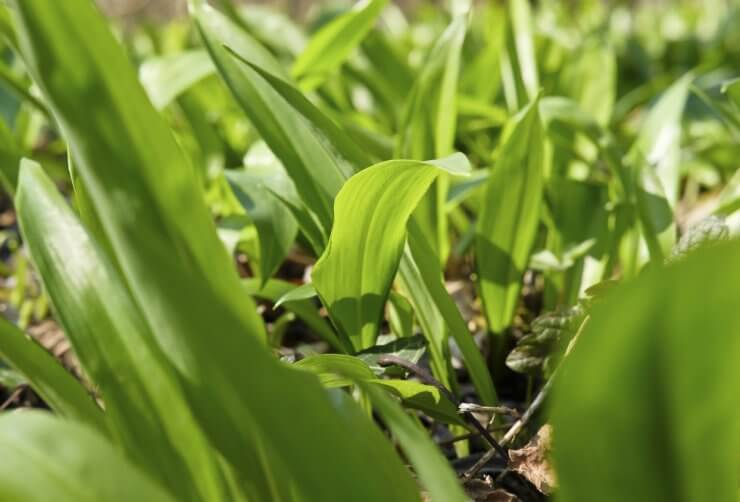
Maybe you’ve experienced this before. You’re innocently weeding your garden bed, humming whatever song has been stuck in your head for three days, when suddenly you spot them. Mysterious green shoots that look suspiciously onion-esque, sprouting where you definitely didn’t plant any onions.
These are volunteer alliums–nature’s way of saying “you’re welcome” in plant form. They’re more common than gardeners realize, and they’ve been turning perfectly rational people into plant detectives since humans first started growing food. The best part? Many of them are edible goldmines hiding in plain sight.
The Allium Family: 700+ Species of Stinky Goodness
The Allium genus contains over 700 species worldwide, ranging from your average cooking onion to ornamental varieties that bloom like purple fireworks. These bulbous plants all share one crucial characteristic: they smell like varying degrees of onion, garlic, or chives when you crush their leaves.
The scientific name “Allium” comes from the Latin word for garlic, which makes sense since the entire family produces those distinctive sulfur compounds. Here’s where the chemistry gets interesting: when you cut an onion and start crying, you’re experiencing syn-propanethial-S-oxide formation in real time. The plant’s enzymes react with sulfur compounds after cell damage, creating a volatile gas that your eyes desperately want to flush out.
Medieval physicians prescribed garlic for everything from plague to heartbreak, and while we can’t vouch for the heartbreak cure, those antimicrobial sulfur compounds actually do pack serious health benefits. Those ancient doctors were onto something scientifically sound, even if their delivery method involved questionable breath quality.
Common Volunteer Alliums
Cultivated Varieties Gone Wild
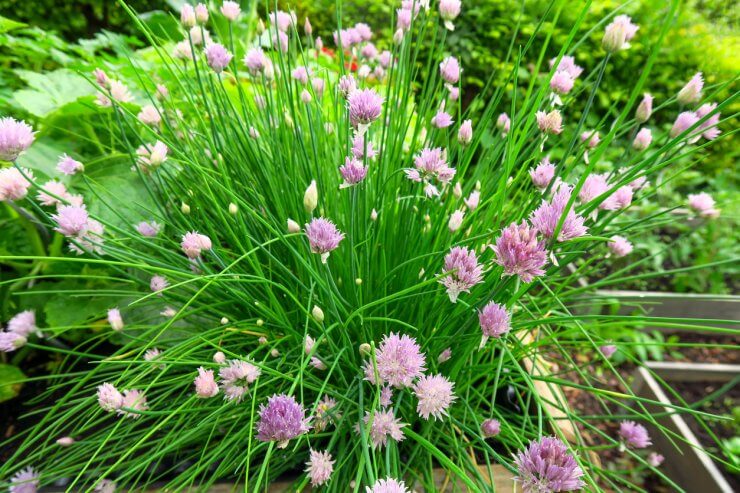
Chives (Allium schoenoprasum): These purple-flowered perennials have distinctive hollow, tubular leaves that grow in dense clumps. The leaves are bright green, about 12 inches tall, and feel smooth and cylindrical when rolled between your fingers. The flowers appear in late spring as tight, round clusters of small purple blooms atop slender stems.
The entire plant is edible. The leaves have a mild onion flavor with a fresh, slightly grassy bite—much gentler than regular onions. The purple flowers are also edible and have a slightly stronger onion taste with a pleasant floral undertone. Even the small bulbs underground can be eaten, though they’re quite tiny. Chives are perfect for situations where you want onion flavor without the intensity or tears.
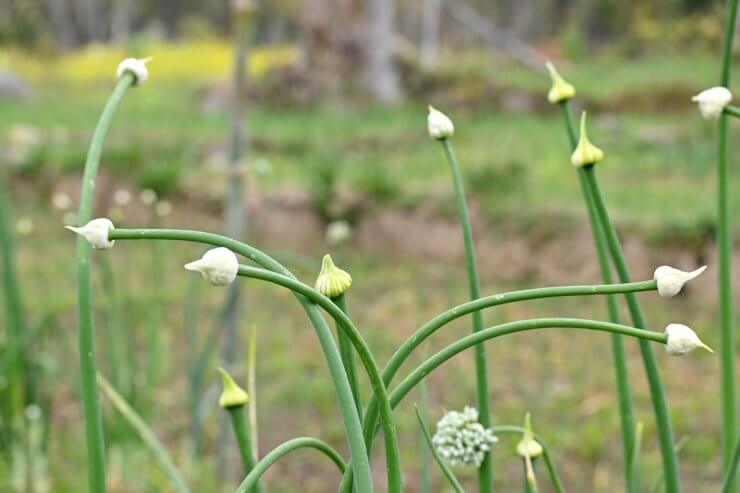
Garlic Scapes and Offspring: Garlic scapes are the curly, twisted flower stalks that emerge from garlic bulbs, topped with small bulbils (tiny garlic cloves). They’re bright green, about 18 inches long, and curl into spirals or loops. The bulbils at the top look like clusters of tiny garlic cloves.
Both the scapes and bulbils are completely edible. Garlic scapes taste like mild garlic with a fresh, green flavor—similar to garlic but without the harsh bite. They have a tender texture when cooked and can be used like asparagus. The bulbils are essentially miniature garlic cloves with concentrated garlic flavor, perfect for pickling or using whole in cooking.

Multiplier Onions: These are onions like potato onions and shallots and look like regular onions, but form clusters of multiple bulbs underground instead of single large bulbs. Above ground, they produce hollow green leaves that resemble thick scallions. The leaves can grow 18-24 inches tall and are darker green than regular onion tops.
The entire plant is edible. The green tops taste like strong scallions with an intense onion bite that’s sharper than store-bought green onions. The clustered bulbs underground have a concentrated, pungent onion flavor that’s stronger than regular onions—use them sparingly until you know their strength. They’re excellent for cooking when you want serious onion flavor.
Native Volunteers
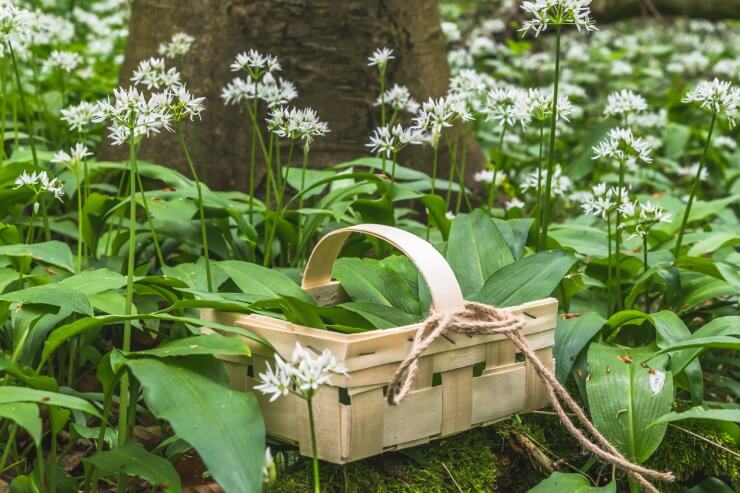
Wild Garlic (Allium ursinum): Also called ramsons, this woodland beauty has broad, glossy leaves that can be easily mistaken for lily-of-the-valley until you smell them. The leaves are typically 2-3 inches wide and 6-8 inches long with prominent parallel veins. In late spring, it produces clusters of white, star-shaped flowers on stems about 12 inches tall.
Every part of this plant is edible and highly prized by foragers. The leaves have a complex garlic flavor that’s milder than regular garlic but with subtle nutty and slightly sweet undertones. Unlike the harsh bite of commercial garlic, wild garlic has a sophisticated depth that develops beautifully when cooked. The white flowers are also edible and pack a concentrated garlicky punch with pleasant floral notes. The small bulbs underground taste like mild garlic and can be used similarly to regular garlic cloves.
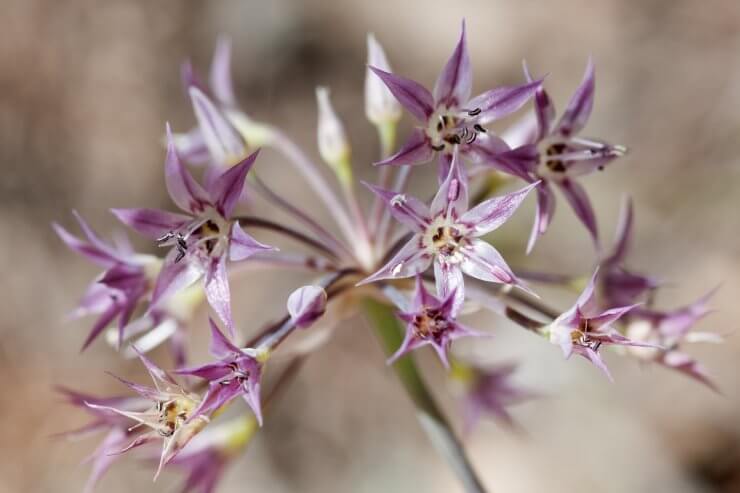
Wild Onion (Allium canadense): This tough North American native looks like thick grass from a distance but reveals its onion identity up close. The leaves are narrow, flat, and typically 12-18 inches tall with a distinctive keeled (ridged) center line. In early summer, it produces small clusters of white or pink flowers at the top of leafless stems.
The entire plant is edible, but be prepared for intensity. Wild onions are typically much stronger than cultivated varieties. The small bulbs have a sharp, pungent onion flavor that can easily overpower a dish if you’re not careful. The green leaves taste like very strong scallions with a bite that’s more aggressive than store-bought green onions. Start with small amounts until you understand their potency. The bulbs can be used like regular onions but require about half the quantity for the same flavor impact.
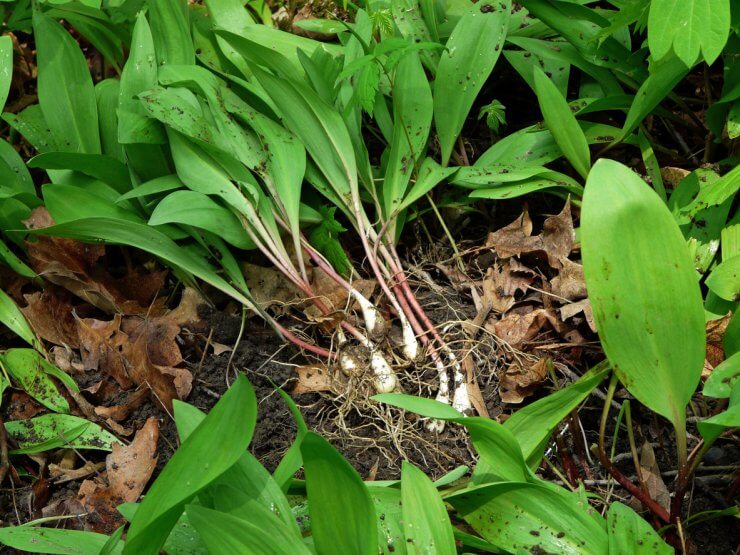
Nodding Onion (Allium cernuum): This graceful native has narrow, flat leaves that grow 12-18 inches long and curve slightly. The distinctive feature is its drooping flower clusters that appear in mid to late summer—pink to white bell-shaped flowers that hang downward like tiny chandeliers on 18-24 inch stems.
All parts of the nodding onion are edible and safe to consume. The flavor is classic onion but more pronounced than regular cooking onions. The bulbs are small (about the size of a large grape) but pack concentrated onion flavor. The leaves can be used like scallions but have a stronger taste. The flowers are edible too and make attractive garnishes with a mild onion flavor. Because the bulbs are small, you’ll need several to substitute for one regular onion in recipes.
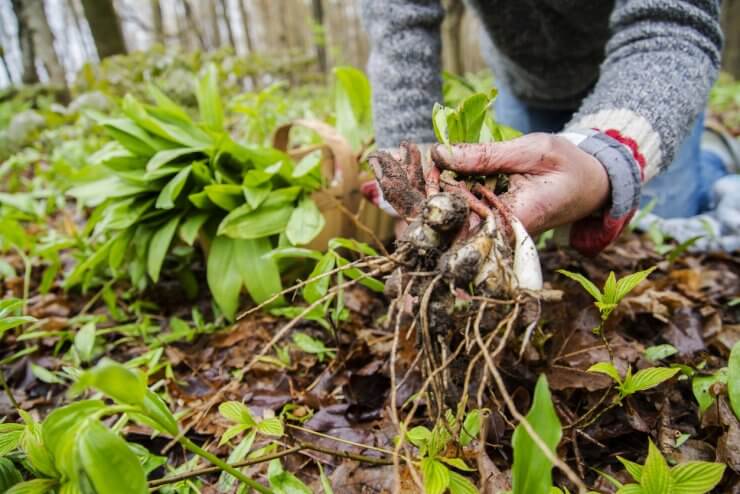
Wild Leeks and Ramps (Allium tricoccum): The holy grail of wild foraging, these woodland treasures are what make spring foragers lose their minds with excitement. Ramps have 2-3 broad, smooth leaves that emerge in early spring, typically 6-10 inches long and 1-2 inches wide. The leaves are bright green with a distinctive red or purple tinge at the base where they meet the white bulb. By late spring, the leaves die back completely before a single flower stalk appears with white clustered blooms.
Every part of the ramp is edible and absolutely prized by chefs and foragers alike. The flavor is complex—imagine if garlic and onions had a sophisticated child who went to culinary school. The bulbs have an intense, pungent garlic-onion flavor that’s both sharp and sweet. The leaves are milder but still pack serious flavor punch, with a texture similar to spinach when cooked. Raw, they have a strong bite that mellows beautifully when sautéed or grilled.
Fair warning: ramps are slow-growing and can take 5-7 years to mature from seed, making them vulnerable to overharvesting. If you find them, harvest sustainably by taking only one leaf per plant or harvesting no more than 20% of a patch.
The Great Identification Game
Step 1: The Smell Test (Your Most Important Tool)
Crush a leaf between your fingers. If it smells like onion, garlic, or chives, you’re dealing with a true allium. No smell? Step away immediately. This simple test eliminates dangerous look-alikes instantly.
The chemistry here is fascinating: crushing the tissue breaks cell walls, allowing the enzyme alliinase to react with amino acid precursors and create those distinctive sulfur compounds. You’re literally witnessing biochemistry in action. Human olfactory receptors are incredibly sensitive to these compounds, which is why even tiny amounts create that unmistakable allium aroma.
Step 2: Leaf Architecture Analysis
Allium leaves come in several signature styles:
- Tubular/Hollow: Like chives and scallions
- Flat and Strap-like: Think garlic varieties
- Broad and Lily-like: Wild garlic territory
That hollow structure in tubular varieties serves a purpose–it maximizes surface area for photosynthesis while minimizing material investment. When you slice them, you’ll see that telltale “onion ring” cross-section.
Step 3: Bulb Investigation
Carefully dig around the base. True alliums will have some form of bulb structure:
- Classic onion-shaped bulbs
- Clusters of small bulblets
- Elongated garlic-style bulbs
- Multiple attached bulbs
Bulbs are underground storage organs–basically plant pantries where they stockpile carbohydrates for survival. The layered structure of onion bulbs consists of modified leaf bases wrapped around each other like botanical Russian dolls.
Step 4: Flower Analysis
Flowering plants hit the identification jackpot. Allium flowers are distinctive:
- Ball-shaped or flat-topped clusters (umbels)
- Colors usually white, pink, purple, or yellow
- Multiple small flowers in spherical arrangements
- Most bloom late spring to early summer
The spherical umbel structure maximizes flower density while creating impressive visual displays that attract pollinators from greater distances. It’s nature’s advertising billboard strategy.
Step 5: Digital Detective Work
Modern plant identification has gone high-tech. Several apps can help confirm your allium suspects:
- PlantNet: Free app with strong accuracy for common species. Upload photos of leaves, flowers, and overall plant structure for identification suggestions.
- Seek by iNaturalist: Uses visual recognition technology and connects to a massive database of user-submitted observations. Great for discovering what others have found in your area.
- PlantIn: A Comprehensive plant care app that includes identification features and growing advice once you’ve confirmed your mystery plant.
- Picture This: This is the one I use. It’s a popular paid app with detailed plant information and care instructions. Particularly good for ornamental allium varieties.
- LeafSnap: Focuses on leaf identification, which works well for alliums with distinctive leaf shapes.
Warning: Use multiple apps for cross-verification, especially with wild plants. No app is 100% accurate, and some handle regional variations better than others. Always combine digital identification with traditional methods like the smell test.
The Danger Zone
Before getting excited about mystery alliums, let’s discuss the botanical villains that might crash your identification party:
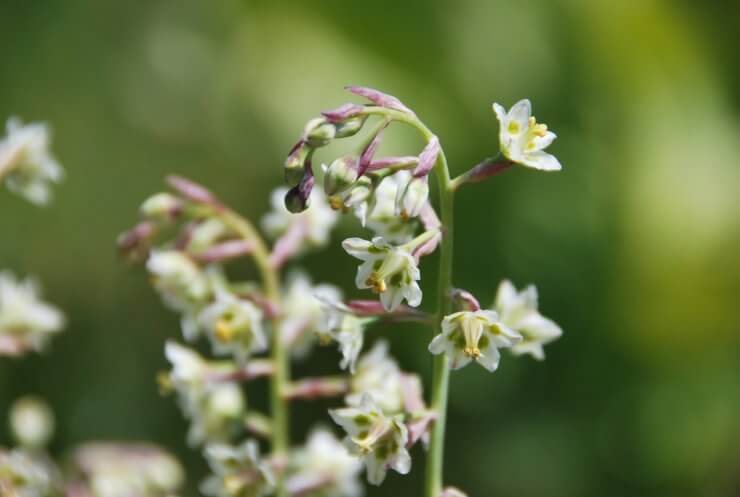
Death Camas (Zigadenus species): Highly toxic and sometimes confused with wild onions. The critical difference? Zero onion smell. This plant contains alkaloids that can cause everything from nausea to cardiac arrest.
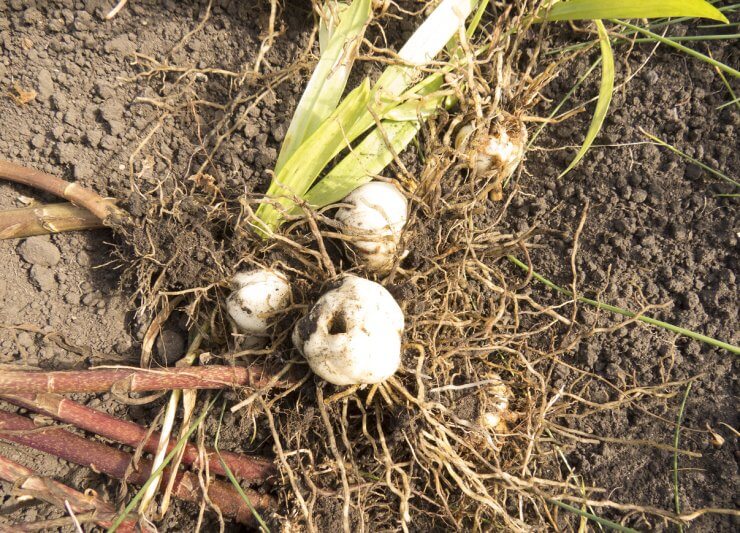
Lily family members: Some have similar bulbs and leaves but lack the characteristic smell. This is where botanical knowledge becomes literally life-or-death important.
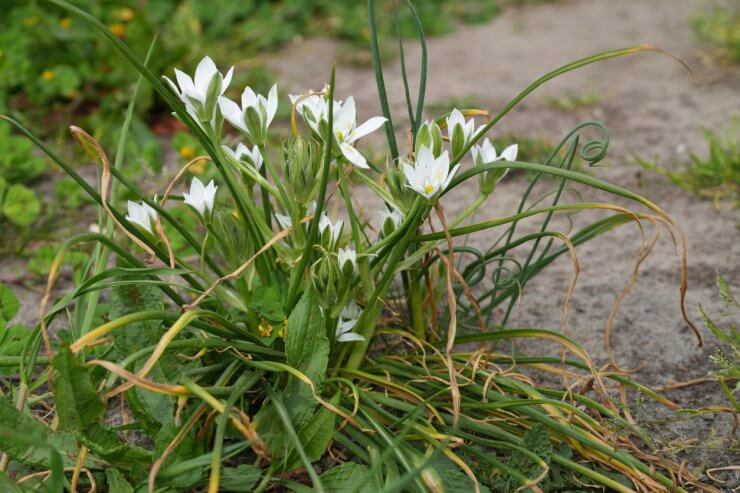
Star-of-Bethlehem (Ornithogalum umbellatum): Pretty white flowers, bulbous roots, but no onion smell and potentially toxic.
Plant misidentification has caused problems since humans first started foraging. Even experienced botanists rely on multiple identification markers. When it comes to edible plants, healthy paranoia is essential.
Golden rule: When in doubt, don’t eat it. No mysterious plant is worth an emergency room visit.
Preparation and Storage
Cleaning: Wild alliums need thorough cleaning. Remove dirt, damaged leaves, and check for insects. Nature doesn’t pre-wash vegetables.
Storage: Greens store well refrigerated in damp paper towels. Bulbs can be stored like regular onions in cool, dry places with good air circulation.
Preservation: Make allium salt, freeze chopped greens in oil-filled ice cube trays, or dehydrate leaves for seasoning blends.
Identification Seasons
- Early Spring: First shoots emerge–perfect identification and harvest time
- Late Spring: Flower buds form–excellent for positive ID
- Early Summer: Peak flowering–pollinator paradise
- Mid-Summer: Seed set begins–future volunteer preparation
- Late Summer: Plants go dormant–bulb division time
- Fall: Seeds disperse naturally–next year’s volunteers get planted
- Winter: Underground bulbs rest while you plan next year’s garden
Climate change is shifting some timing, so keep notes about local patterns.
Troubleshooting Common Scenarios
“It Smells Like Onion But Looks Weird”
Wild genetics can produce unusual leaf shapes, different growth patterns, unexpected flower colors, and varying sizes. This diversity is a feature, not a bug–you’re seeing full genetic potential unrestricted by human selection for uniformity.
“They’re Everywhere!”
Enthusiastic self-seeders can quickly populate areas. Management strategies:
- Deadhead flowers before seed set (save some for pollinators)
- Dig excess bulbs for relocation or composting
- Use as living mulch around other plants
- Share with fellow gardeners
Mystery alliums represent everything wonderful about gardening: discovery, sustainability, connection to nature, and the possibility that your next amazing meal ingredient is growing wild in your backyard right now.
Success requires patience, observation, and healthy respect for plant safety. Always prioritize the smell test, never eat unidentified plants, and remember that the best garden discoveries come from paying attention to what’s already there.
Your mystery onions might be common chives or rare native treasures. They might be aggressive spreaders or shy bloomers. Whatever they are, they’re reminders that gardens are wild places at heart, full of surprises for observant gardeners.
Now that you’re armed with identification superpowers and scientific curiosity, you’re ready to solve whatever oniony mysteries your garden presents. Happy detecting, fellow plant sleuths. May your mystery alliums be numerous, delicious, and just unpredictable enough to keep gardening interesting.
Remember: When in doubt about plant identification, consult local extension services, master gardener programs, or experienced foragers. No article can replace hands-on expertise and local knowledge for plant safety.
What to learn more about cultivating the onions you actually want? Onions make everything taste better! From burgers to salads to soups and more, onions offer a broad range of flavors from sweet to zesty. Gardeners love to grow them, and their friends and family love to eat them—raw or cooked! With The Outstanding Onion Gardening Guide, you’ll have everything you need to know about growing and enjoying this versatile food.


 Previous
Previous

